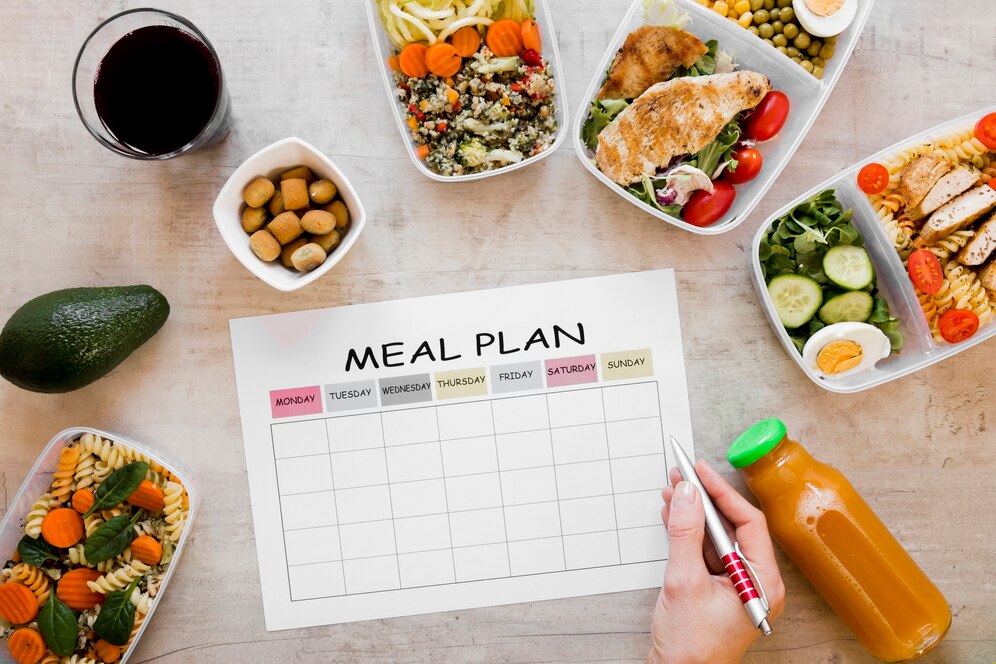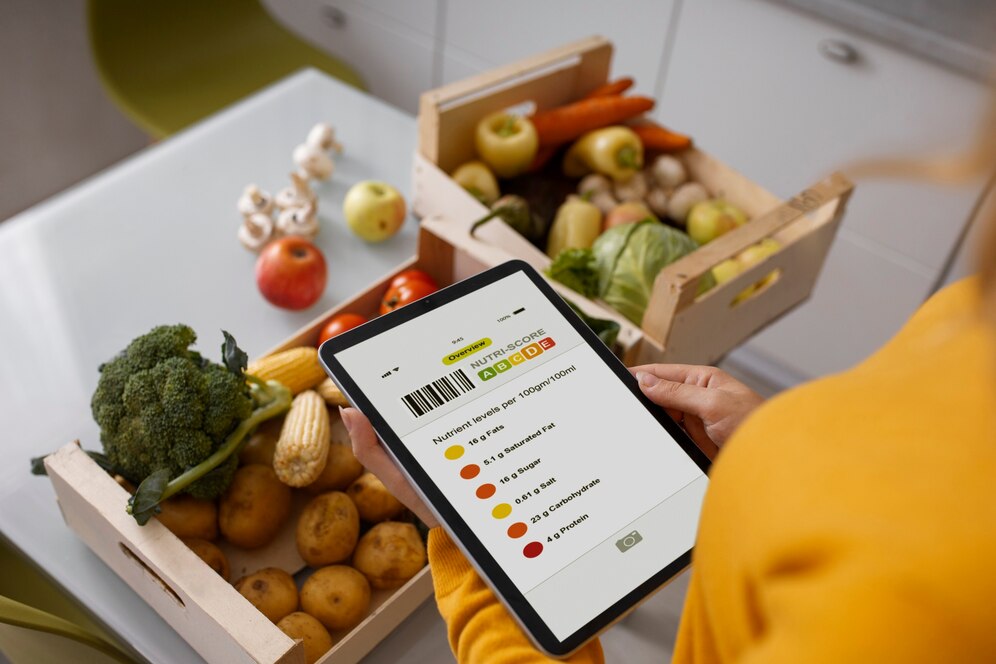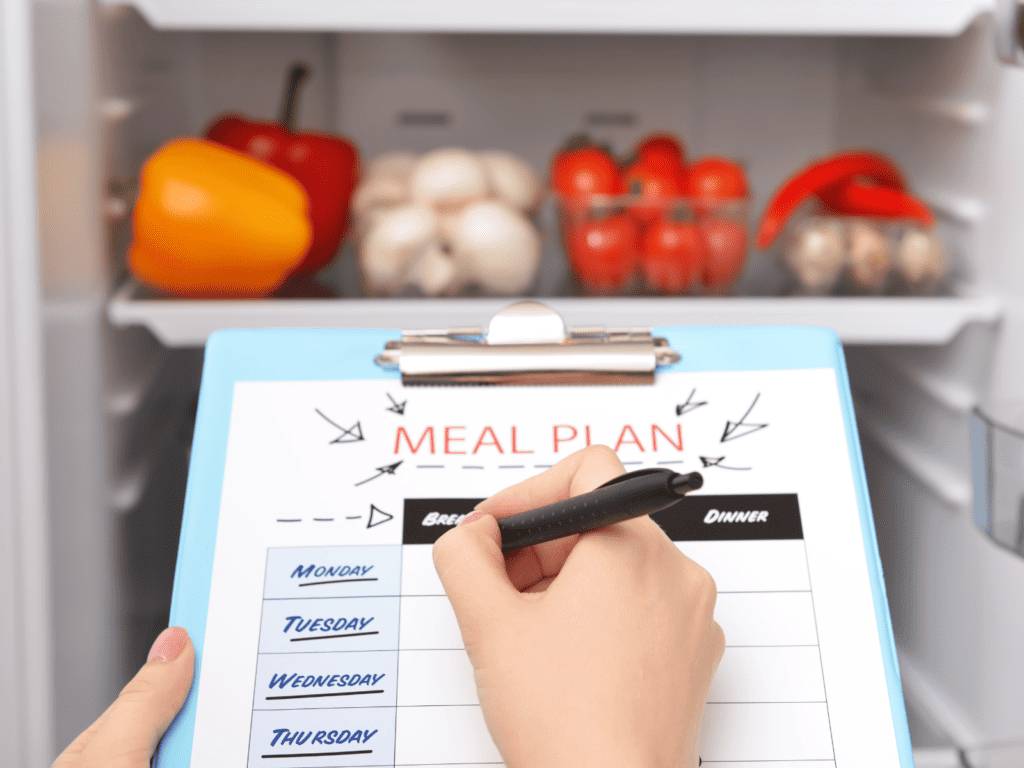The Food Blog

How to Meal Plan Like a Pro: A Beginner’s Guide
Do you ever come home at the end of a long day, stare into the fridge to wonder what to cook, and end up ordering takeaway instead? You’re not alone. Meal planning can be your secret weapon to saving time, money, and stress while helping you eat healthier.
Meal planning isn’t just about choosing meals; it’s about designing an approach that makes grocery shopping, cooking, and eating more efficient. Once you get the hang of it, you’ll wonder how you ever managed without it. Whether you’re trying to save money, eat healthier, or reduce the daily mental load of deciding what to cook, meal prepping is a skill that pays off.
This guide will walk you through the basics of meal prep, from smart shopping lists to efficient cooking techniques. By the end, you’ll have a framework for planning meals like a pro—no more last-minute dinner scrambles or unnecessary takeout.
Quick Guide: Meal Planning Like a Pro

- Assess Your Needs: Identify dietary preferences, portion sizes, and available cooking time to create a plan tailored to your lifestyle.
- Choose Simple Recipes: Start with easy-to-follow meals like one-pot dishes and casseroles. Rotate ingredients to keep things interesting without overcomplicating prep.
- Organise Your Shopping List: Group items by sections (produce, dairy, etc.) and check your pantry first to avoid duplicates. Use apps for an easy-to-manage shopping experience.
- Prep in Batches: Prepare key ingredients in bulk—wash veggies, cook grains, and marinate proteins to save time during the week.
- Stay Flexible: Have backup meals ready, adjust plans if needed, and embrace a relaxed approach to meal prep to avoid stress.
The Benefits of Meal Planning

Before diving into the “how,” let’s explore why meal planning is worth your time:
- Saves Time – No more daily decisions about what to eat. Planning ahead means fewer last-minute trips to the store and more free time.
- Reduces Waste – Buy only what you need, cutting down on food waste. The average UK household wastes around £700 worth of food annually—meal planning can help lower this.
- Saves Money – Planning meals prevents unnecessary purchases and reduces the temptation to eat out. Sticking to a list also helps avoid impulse buys.
- Encourages Healthy Eating – Pre-planned meals are often healthier than spontaneous choices. It’s easier to stick to balanced meals when you’ve already decided what to cook.
- Reduces Stress – No more last-minute scrambles or dinner debates. Knowing what’s for dinner each night makes evenings more relaxed.
Step 1: Assess Your Needs and Set Goals
Start by understanding your unique needs:
- Dietary Preferences – Vegetarian? Gluten-free? Keto? Choose meals that suit your lifestyle.
- Number of Meals – Will you prep all meals or just dinners?
- Portion Sizes – Cooking for one or a family? Adjust recipes to avoid waste.
- Time Commitment – Pick recipes that fit your available cooking time.
Pro Tip: Start small. Plan just 3-4 dinners per week if you’re new to meal planning. This keeps things manageable.
Step 2: Choose Your Recipes Wisely
Selecting recipes is where the fun begins! Follow these tips:
- Keep It Simple – Stick to meals with fewer ingredients and easy steps. One-pot meals or sheet pan dinners are great for busy nights.
- Balance Variety and Convenience – Rotate proteins and cuisines to keep things interesting without making meal prep a chore.
- Incorporate Overlapping Ingredients – Roast a large batch of veggies to use in salads, wraps, and side dishes throughout the week.
- Consider Batch Cooking – Soups, stews, and casseroles make great leftovers. Dishes like chili or curry often taste better the next day.
Step 3: Make a Detailed Shopping List
A well-organized shopping list makes grocery trips faster and more efficient:
- Organise by Section – Group items by produce, dairy, pantry staples, etc., to save time.
- Check Your Pantry First – Avoid buying duplicates.
- Be Flexible – If an item is out of stock or on sale, be ready to swap ingredients.
Bonus Tip: Apps like AnyList or Google Keep are great for digital lists you can check off while shopping.
Step 4: Master the Art of Meal Prep
Time to put your plan into action:
- Start with Prep Work – Wash and chop veggies, marinate proteins, and portion out snacks to make cooking faster during the week.
- Cook in Batches – Roast veggies, cook grains, and prepare proteins in bulk for easy mix-and-match meals.
- Use Proper Storage – Airtight containers keep meals fresh. Glass containers are great since they don’t absorb odours and are microwave-safe.
- Label Everything – Use masking tape to note the date and meal name to avoid mystery meals.
Important Time-Saving Hack: Set aside 1-2 hours on a Sunday to prep for the week ahead. Play music or a podcast to make it fun.
Step 5: Stay Flexible and Adapt
Even the best-laid plans can change. Keep these pointers in mind:
- Have Backup Meals – Keep a few quick meals (like pasta and jarred sauce) for emergencies.
- Adjust As Needed – If plans change, repurpose ingredients for different meals.
- Embrace Imperfection – Some weeks will be smoother than others. The key is consistency, not perfection.
Common Pitfalls and How to Avoid Them

- Overcomplicating It – Stick to simple recipes, especially at the start.
- Not Prepping Enough – Prep key ingredients in advance to make cooking easier.
- Ignoring Portions – Cook only what you’ll realistically eat to avoid waste.
- Skipping Flexibility – Plans should be guidelines, not rigid rules. Adapt as needed.
Frequently Asked Questions About Meal Planning
How do I start meal planning if I have a busy schedule?
Start with just a few meals per week and opt for quick, simple recipes like one-pan dishes or slow cooker meals.
How long does meal prep take?
It depends on your plan. A basic prep session can take 1-2 hours, but batch cooking can save time later in the week.
Can I meal plan on a budget?
Absolutely! Plan meals around seasonal produce, sales, and ingredients you already have at home.
How do I keep my meals fresh for the whole week?
Use airtight containers, refrigerate properly, and freeze meals when necessary to maintain freshness.
What if I don’t want to eat the same thing every day?
Choose versatile ingredients that can be used in multiple ways (e.g., grilled chicken for salads, wraps, or pasta).
How can I make meal planning easier?
To simplify the process, use apps, follow meal prep guides, and create a rotating meal schedule.
Your Meal Planning Journey Begins
Meal planning isn’t about rigid control but rather a system that works for you. Start small, remain flexible, and soon you’ll be meal prepping like a pro.
As you get comfortable, your own shortcuts and preferences will emerge. Whether you’re preparing for a busy workweek or aiming to eat healthier, these meal planning tips will set you up for success.
Ready to get started? Open your favourite recipe app and plan your meals for the week—enjoy the peace of mind that comes with knowing what’s for dinner.









